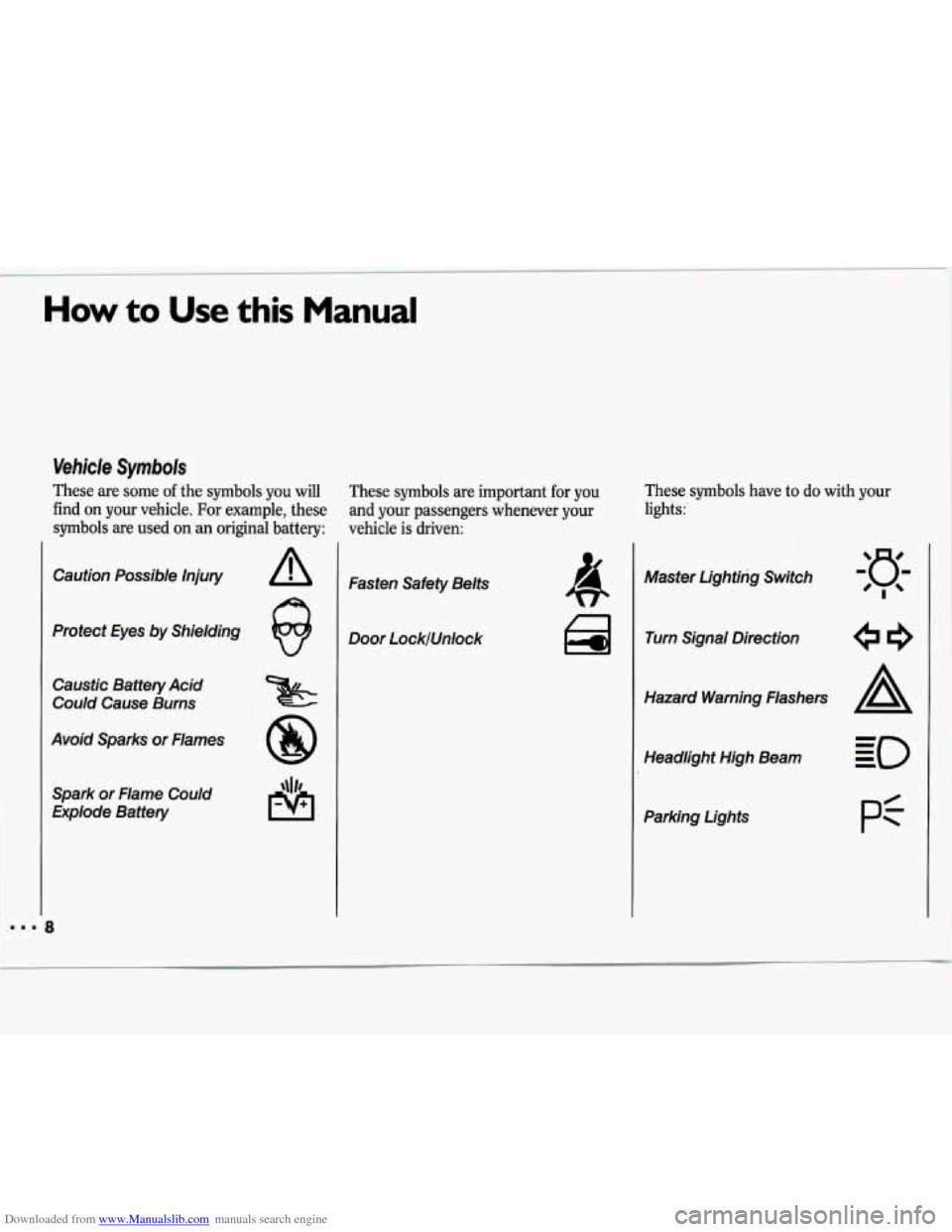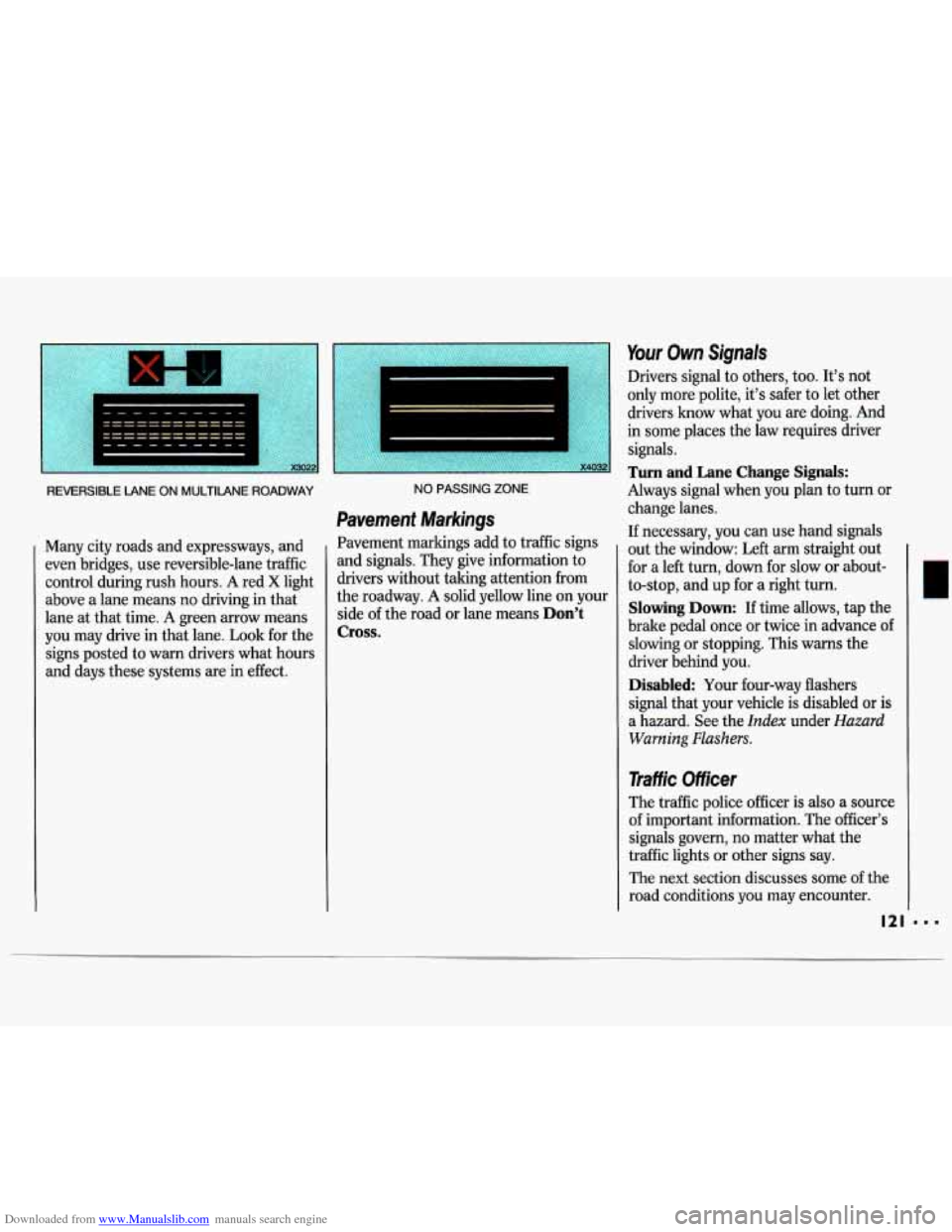1993 CHEVROLET LUMINA turn signal
[x] Cancel search: turn signalPage 10 of 324

Downloaded from www.Manualslib.com manuals search engine How to Use this Manual
Vehicle Symbols
These are some of the symbols you will
find on your vehicle. For example, these
symbols
are used on an original battery: These symbols
are important for you
and your passengers whenever your
vehicle is driven: These
symbols have
to do with your
lights:
Caution Possible Injury
Protect
Eyes by Shielding
Caustic Battery Acid
Could Cause Burns
Avoid Sparks or Flames
Spark or Flame Could
Explode Battery Fasten Safety Belts
Door Lock/Unlock
la Turn Signal Direction
Hazard Warning Flashers
Headlight High Beam
Parking Lights
pf
Page 72 of 324

Downloaded from www.Manualslib.com manuals search engine Features & Controls
Turn Si'llHeadlight
Beam kver
The lever on the left side of the steering
column includes your:
Turn Signal and Lane Change
Headlight High-Low Beam
Windshield Wipers
Windshield Washer
Cruise Control (Option)
Indicator
Turn Signal and Lane Change
Indicator
The turn signal has two upward (for
Right) and
two downward (for Left)
positions. These positions allow you to
signal a turn or a lane change.
To Signal a Turn:
Move the lever all the way up or down.
When the turn is finished, the lever will
return automatically.
I
A green arrow on the instrument panel
will flash in the direction of the turn or
lane change.
To signal a lane change, just raise or
lower the lever until the green arrow
starts to flash. Hold it there until you
complete your lane change. The lever
will return by itself when you release it.
As you signal a turn or a lane change, if
the arrows don't flash but just stay
on, a
signal bulb may be burned out and
other drivers won't see your turn signal.
If a bulb is burned out, replace it to help
avoid an accident.
If the green arrows
don't go
on at all when you signal a
turn, check the fuse (see the
Index
under Fuses G. Circuit Breakers) and
for burned-out bulbs.
Page 80 of 324

Downloaded from www.Manualslib.com manuals search engine Features & Controls
Daytime Running Lights
(CANADA ONLY)
The Canadian Federal Government has decided that
Daytime Running Lights
(DRL) are a useful feature, in that DRL
can make your vehicle more visible to
pedestrians and other drivers during daylight hours. DRL are required
on
new vehicles sold in Canada.
Your DRL work with a light sensor on
top
of the instrument panel. Don’t
cover it up.
The low beam headlights will come
on
at reduced brightness in daylight when:
The ignition is on
The headlight switch is off, and
The parking brake is released. At dusk,
the exterior lights will come on
automatically and the low beams will
change to full brightness. At dawn, the
exterior lights will go out and the low
beams will change to the reduced
brightness of DRL (if the headlight
switch is
off).
Of course, you may still turn on the
headlights any time you need to.
To idle your vehicle with the
DRL off,
set the parking brake while the ignition
is in the
Off or Lock position. Then
start the vehicle. The DRL will stay
off
until you release the parking brake.
L I
c
Headlight High-Low Beam
Changer
I
To change the headlights from low
beam to high
or high to low, pull the
turn signal lever all the way toward you.
I
Then release it.
When the high beams are
on, a blue
light on the instrument panel also will
be on.
78
Page 89 of 324

Downloaded from www.Manualslib.com manuals search engine Warning Lights, Gages and
Indicators
This section describes the warning lights
and gages that may be on your vehicle.
The pictures will help you locate them.
Warning lights and gages can signal that
something is wrong before it becomes
serious enough to cause an expensive
repair or replacement. Paying attention
to your warning lights and gages could
also save you or others
from injury.
Warning lights go on when there may
be or is a problem with one of your
vehicle’s functions.
As you will see in the
details on the next few pages, some
warning lights come on briefly when
you turn the ignition key just to let you
lmow they’re working. If you are
familiar with this section, you should
not be alarmed when this happens.
Gages can indicate when there may be
or is a problem with one
of your
vehicle’s functions. Often gages and
warning lights work together to let you
know when there’s a problem with your
vehicle. When
one of the warning lights comes
on and stays on when you are driving,
or when one of the gages shows there
may be a problem, check the section
that tells you what to do about it. Please
follow the manual’s advice. Waiting to
do repairs can be costly-and even
dangerous, So please get to how your
warning lights and gages. They’re a big
help.
87
Page 120 of 324

Downloaded from www.Manualslib.com manuals search engine Your Driving and the Road
Road Signs
The road signs you see everywhere are coded by color, shape and symbols. It’s
a good idea to lmow these codes
so that
you can quickly grasp the basic meaning
or intent
of the sign even before you
have a chance to read it.
Color of Road Signs
Red means Stop. It may also indicate
that some movement is not allowed.
Examples are
Do Not Enter, Wrong
Way,
or No Parking.
Green
is used to guide the driver.
Green signs may indicate upcoming
freeway exits or show the direction you
should turn to reach a particular place.
RR ADVANCE NARROW NO PASSING
CROSSING BRIDGE ZONE
Yellow indicates a general warning.
Slow down and be careful when you see
a yellow sign. It may signal a railroad
crossing ahead, a no passing zone, or
some other potentially dangerous
situation. Likewise, a yellow solid line
painted on the road means
Don’t Cross.
HOSPITAL INFORMATION
Blue signs with white letters show
motorists’ services.
Page 123 of 324

Downloaded from www.Manualslib.com manuals search engine REVERSIBLE LANE ON MULTILANE ROADWAY
Many city roads and expressways, and
even bridges, use reversible-lane traffic control during rush hours.
A red X light
above
a lane means no driving in that
lane at that time.
A green arrow means
you may drive in that lane.
Look for the
signs posted to warn drivers what hours
and days these systems are in effect.
NO PASSING ZONE
Pavement Markings
Pavement markings add to traffic signs
and signals. They give information to
drivers without taking attention from
the roadway.
A solid yellow line on your
side of the road or lane means
Don’t
Cross.
Your Own Signals
Drivers signal to others, too. It’s not
only more polite, it’s safer to let other
drivers know what you are doing. And
in some places the law requires driver
signals.
Turn and Lane Change Signals:
Always signal when you plan to turn or
change lanes.
If necessary, you can use hand signals
out the window: Left arm straight out
for a left turn, down for slow or about-
to-stop, and up for a right turn.
Slowing Down: If time allows, tap the
brake pedal once or twice in advance of
slowing or stopping. This warns the
driver behind you.
Disabled Your four-way flashers
signal that your vehicle is disabled or
is
a hazard. See the Index under Hazard
Warning Flashers.
Traffic Officer
The traffic police officer is also a source
of important information. The officer’s
signals govern, no matter what the
traffic lights or other signs say.
The next section discusses some of the
road conditions you may encounter.
Page 137 of 324

Downloaded from www.Manualslib.com manuals search engine Watch for traffic signs, pavement markings, and lines. If you can see a
sign up ahead that might indicate a
turn or an intersection, delay your
pass.
A broken center line usually
indicates it’s all right to pass
(providing the road ahead is clear).
Never cross a solid line on your side
of the lane or
a double solid line, even
if the road seems empty of
approaching traffic.
If you suspect that the driver of the
vehicle you want to pass isn’t aware
of your presence, tap the horn
a
couple of times before passing.
Do not get too close to the vehicle
you want to pass while you’re
awaiting an opportunity. For one
thing, following too closely reduces
your area of vision, especially if you’re
following a larger vehicle.
Also, you
won’t have adequate space
if the
vehicle ahead suddenly slows or stops. Keep back a reasonable
distance.
When it looks like a chance to pass is
coming up, start to accelerate but stay
in the right lane and don’t get too
close. Time your move
so you will be
increasing speed as the time comes to
move into the other lane. If the way is
clear to pass, you will have a “running
start” that more than makes up for
the distance you would lose by
dropping back. And
if something
happens to cause you to cancel your
pass, you need
only slow down and
drop back again and wait for another
opportunity.
slow vehicle, wait your turn.
But tale
care that someone isn’t trying to pass
you as you pull out to pass the slow
vehicle. Remember to glance over
your shoulder and check the blind
spot.
If other cars are lined up to pass a
Check your mirrors, glance over your
shoulder, and start your left lane
change signal before moving out of
the right lane to pass. When you are
far enough ahead of the passed
vehicle to see its front in your inside
mirror, activate your right lane change signal and move back into the right
lane. (Remember that your right
outside mirror is convex. The vehicle
you just passed may seem to be
farther away from you than it really is.)
Try not to pass more than one vehicle
at a time on two-lane roads.
Reconsider before passing the next
vehicle.
vehicle too rapidly. Even though the
brake lights are not flashing, it may be
slowing down or starting to turn.
If you’re being passed, make it easy
for the following driver to get ahead of
you. Perhaps you can ease a little to
the right.
Don’t overtake a slowly moving
Page 141 of 324

Downloaded from www.Manualslib.com manuals search engine Remember that your headlights light up
far less of
a roadway when you are in a
turn or curve.
Keep your eyes moving; that way, it’s
easier to pick out dimly li@ted objects.
Just as
your headlights should be
checked regularly for proper aim,
so
should your eyes be examined regularly. Some drivers suffer
from night
blindness-the inability to see in dim
light-and aren’t even aware
of it. Rain and
wet roads can mean driving
trouble.
Qn a wet road.you can’t stop,
accelerate or turn
as well because your
tire-to-road traction isn’t as good
as on
dry roads. And, ifyour tires don’t have
much tread lea, you’ll get even less
traction.
It’s always wise to go slower and be
cautious
if rain starts to fall while you
are driving. The surface may get wet
suddenly when your reflexes are tuned
for driving on dry pavement.
The heavier the rain, the harder it is to
see. Even
if your windshield wiper
blades are in good shape, a heavy rain
can make it harder to
see road signs and
traffic signals, pavement markings, the
edge of the road, and even people